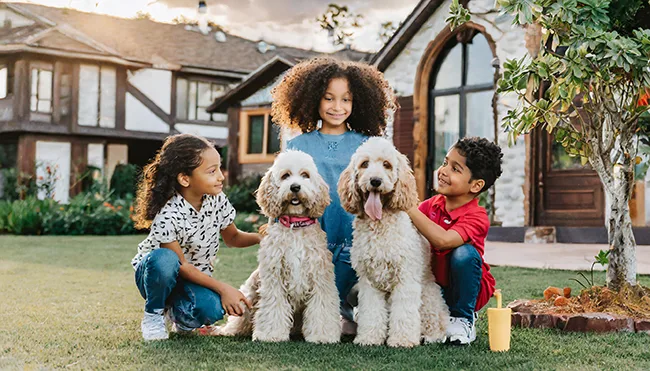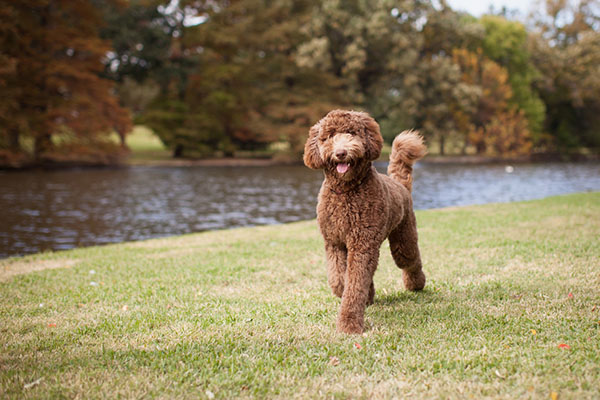
Consider a furry buddy who not only jumps for excitement at the sight of you but also serves as a soft, hypoallergenic pillow. Enter the Labradoodle, a lovely cross between the devoted Labrador Retriever and the astute Poodle. This endearing hybrid has captured the hearts of people all around the world, not only for their adorable ‘teddy bear‘ looks but also for their friendly and gentle personality. Whether you enjoy lengthy, adventurous excursions or cosy afternoons at home, the Labradoodle adapts with the ease of a creature created to bring happiness. As we delve into the fluffy world of Labradoodles, let us discover the beauty behind these curly companions and why they could be the ideal addition to your family.
Table of Contents
- Origins and History
- Characteristics
- Types of Labradoodles
- Understanding the Different Generations
- Living with a Labradoodle
- Exercise Requirements
- Dietary Considerations
- Grooming Needs
- Socialization and Training
- Health and Care of Labradoodles
- Choosing a Labradoodle
- Labradoodles as Family Pets
- Conclusion
Origins and History
The Creation of the Labradoodle

The Labradoodle made its debut in the late 1980s, born from an innovative idea to combine the best traits of two beloved breeds: the Labrador Retriever and the Poodle. This crossbreed was initially developed in Australia by breeder Wally Conron. The goal was to create a guide dog suited for individuals with allergies to dog fur and dander. Labrador Retrievers were already well-known for their friendly nature, intelligence, and reliability as service dogs, while Poodles were prized for their hypoallergenic coats and sharp minds.
Initial Purpose
The primary aim behind the creation of the Labradoodle was to engineer a dog that could serve as an effective guide or assistance animal without triggering allergic reactions in their handlers. The hypoallergenic coat of the Poodle, combined with the Labrador’s disposition and trainability, seemed like the perfect match. Conron’s efforts were aimed at providing a solution for those in need of assistance dogs who were also allergic to dog hair and dander. The first Labradoodle, named Sultan, proved that dogs could be both hypoallergenic and excellent service animals, embodying the best qualities of both breeds.
Evolution of the Breed Over the Years
Since the Labradoodle’s inception, the breed has gained immense popularity, not just as service dogs but also as family pets. The breed has evolved, with breeders experimenting with various generations of crossbreeding (e.g., F1, F1B, F2 generations) to refine certain characteristics, such as coat type and temperament. An F1 Labradoodle is a direct cross between a purebred Labrador Retriever and a purebred Poodle, while F1B refers to a Labradoodle bred back to a purebred Poodle, and so on. This has resulted in a variety of Labradoodles, with some having more Poodle-like coats and others retaining more of the Labrador’s features.
The Australian Labradoodle Association and similar organizations have worked towards establishing the Labradoodle as a breed in its own right, focusing on consistency in health, temperament, and appearance. These efforts include creating breeding standards and guidelines to ensure the health and well-being of the Labradoodle population.
As the Labradoodle continues to charm people around the globe, it stands as a testament to the success of thoughtful, purpose-driven crossbreeding. Their story is not just about creating a new dog breed; it’s about innovation, compassion, and the enduring bond between humans and their canine companions.
Characteristics

Labradoodles are a fascinating mix of their parent breeds, the Labrador Retriever and the Poodle, resulting in a range of characteristics that make them highly sought after as pets. Let’s explore their physical characteristics, temperament, personality traits, and genetic health considerations.
Physical Characteristics
- Size: Labradoodles come in a variety of sizes, largely depending on the size of the Poodle parent. They can be categorized into standard, medium, and miniature. Standard Labradoodles typically weigh between 50 to 65 pounds, medium ones weigh around 30 to 45 pounds, and miniature Labradoodles weigh 15 to 25 pounds.
- Coat Types: Their coats can vary significantly, from the curly and low-shedding coat reminiscent of the Poodle to the straighter, denser coat of the Labrador. There are three main types of Labradoodle coats: wool (similar to a Poodle’s coat, with tight curls and hypoallergenic), fleece (soft and wavy and considered low to non-shedding), and hair (which is closer to a Labrador’s coat and may shed).
- Colors: The color palette of their coats is also diverse, including black, white, cream, gold, apricot, chocolate, and sometimes even multi-colored or parti patterns.
Temperament and Personality Traits
Labradoodles are known for their friendly and affectionate nature, making them excellent family pets. They inherit the intelligence and high trainability of both their parent breeds, which makes them suitable for a variety of roles, including service and therapy dogs. They are typically energetic and playful, requiring regular exercise to keep them healthy and happy. Their sociable disposition means they usually get along well with other dogs and pets, as well as with children.
- Intelligence: Highly intelligent and eager to please, they respond well to training.
- Sociability: They are known for being friendly and do well in homes with children and other pets.
- Adaptability: Labradoodles can adapt to a variety of living situations as long as they have enough space to play and exercise.
Genetic Health Considerations
While crossbreeding can lead to healthier dogs due to genetic diversity, Labradoodles are still susceptible to certain health issues common to their parent breeds. Prospective owners should be aware of these potential health concerns:
- Hip and Elbow Dysplasia: A common condition in larger breeds, including Labradors and Poodles, which can lead to discomfort and mobility issues.
- Eye Disorders: Including progressive retinal atrophy, cataracts, and glaucoma.
- Ear Infections: Their floppy ears can trap moisture and lead to infections, so regular cleaning is necessary.
- Addison’s Disease: A less common but serious condition that affects the dog’s adrenal glands.
Responsible breeding procedures, such as health examinations for breeding dogs, can help reduce the risk of these and other genetic disorders. Regular veterinary check-ups and a healthy lifestyle are also essential for ensuring that a Labradoodle has a long and happy life.
In short, Labradoodles are versatile, affectionate, and intelligent dogs with a variety of physical characteristics and some genetic health considerations to keep in mind. Their adaptable and friendly nature makes them beloved pets in many households.
Types of Labradoodles
Labradoodles come in various types and generations, each with its unique characteristics. Understanding these differences is crucial for prospective owners to choose the Labradoodle that best fits their lifestyle and preferences. Let’s explore the distinctions between Australian and American Labradoodles and the meaning behind the different generational labels.
Australian Labradoodles vs. American Labradoodles
Australian Labradoodles

Australian Labradoodles are not simply a cross between a Labrador Retriever and a Poodle, but rather a multi-generation breed that includes genetics from the English and American Cocker Spaniel in their lineage. This breeding aims to produce a consistent type in terms of coat, size, and temperament. Australian Labradoodles were developed to solidify desirable traits, such as non-shedding coats and a friendly, intelligent disposition. They are generally recognized by various international Labradoodle associations and have strict breeding standards.
American Labradoodles

American Labradoodles, on the other hand, typically refer to the first-generation (F1) and sometimes second-generation (F2) crosses directly between Labrador Retrievers and Poodles. These Labradoodles may vary more in terms of coat type, shedding, and temperament due to the direct and diverse nature of their parentage. American Labradoodles can have a wider range of physical characteristics and may not always have the hypoallergenic coat that many seek in a Labradoodle.
Understanding the Different Generations
The terminology used to describe the generations of Labradoodles (F1, F1B, F2, F2B, etc.) helps to understand the mix and what to expect in terms of shedding, coat type, and temperament:
- F1 Labradoodles: This is the first generation resulting from breeding a purebred Labrador Retriever with a purebred Poodle. F1 Labradoodles have a 50/50 mix of each breed, resulting in a wider variety of coat types, from wavy to curly, and they may or may not be hypoallergenic.
- F1B Labradoodles: The “B” stands for “backcross,” and F1B Labradoodles are the result of breeding an F1 Labradoodle back to a purebred Poodle. This increases the Poodle’s hypoallergenic trait to 75%, making F1B Labradoodles more likely to have a curly, non-shedding coat.
- F2 Labradoodles: These are second-generation Labradoodles produced by breeding two F1 Labradoodles. F2 Labradoodles can have a range of coat types and shedding properties, similar to F1s, but with potentially more consistency in traits due to the reinforced Labradoodle genetics.
- F2B Labradoodles: An F2B Labradoodle is the result of breeding an F2 Labradoodle back to a Poodle, enhancing the Poodle’s traits, especially the likelihood of a non-shedding coat and hypoallergenic qualities.
- F3 or Multi-Generation Labradoodles: These Labradoodles are the result of breeding two Labradoodles beyond the second generation (F2 or F2B). Multi-generational breeding aims for a consistent set of characteristics in terms of coat, size, and temperament, similar to the breeding goals of Australian Labradoodles.
In summary, the type and generation of a Labradoodle can significantly influence its characteristics. Australian Labradoodles are bred for consistency and often meet the hypoallergenic and temperament standards many families seek. In contrast, American Labradoodles and various generational crosses offer a spectrum of traits influenced by their closer lineage to purebred Labrador Retrievers and Poodles.
Living with a Labradoodle
Living with a Labradoodle can be a joyous and fulfilling experience. These intelligent, affectionate dogs make excellent companions, but they do come with specific needs in terms of exercise, diet, grooming, and training. Here’s what you need to know to ensure your Labradoodle lives a happy, healthy life.
Exercise Requirements
Labradoodles are energetic and playful, requiring regular exercise to maintain their physical and mental health. A combination of physical activities and mental stimulation works best for this breed.
- Daily Exercise: Aim for at least 30 to 60 minutes of exercise each day. This can include walks, runs, playtime in a fenced yard, or trips to the dog park.
- Mental Stimulation: Labradoodles thrive on challenges and learning. Incorporate training sessions, puzzle toys, and games like hide-and-seek to keep their minds active.
Dietary Considerations
A balanced diet is crucial for your Labradoodle’s overall health. The right food can help maintain their energy levels, support joint health, and keep their coat shiny and healthy.
- High-Quality Dog Food: Choose a high-quality dog food appropriate for their age, size, and activity level. Consult with your veterinarian to determine the best diet plan.
- Portion Control: Be mindful of portion sizes to prevent overfeeding, which can lead to obesity and related health issues.
- Treats: Use treats sparingly and opt for healthy options. Treats should not make up more than 10% of your dog’s daily caloric intake.
Grooming Needs
Labradoodles’ coats can vary greatly, from wavy and curly to straight, impacting their grooming needs. Regular grooming helps prevent matting and skin issues and keeps them looking their best.
- Brushing: Brush your Labradoodle several times a week to prevent tangles and matting, especially for those with curlier coats.
- Bathing: Bathe your Labradoodle every 4-6 weeks or as needed. Use a dog-specific shampoo to protect their skin and coat.
- Professional Grooming: Depending on their coat type, professional grooming every 6-8 weeks can help them manage their coat, trim nails, and clean their ears.
Socialization and Training
Early socialization and consistent training are key to raising a well-behaved Labradoodle. They are eager to please and learn quickly, but like all dogs, they benefit from clear guidance.
- Socialization: Expose your Labradoodle to a variety of people, animals, and environments early on. Positive experiences help them become well-adjusted adults.
- Training: Start basic obedience training early. Use positive reinforcement techniques such as treats and praise to encourage good behavior.
- Consistency: Be consistent with commands and rules. Consistency helps your Labradoodle understand expectations and strengthens your bond.
Living with a Labradoodle is a rewarding experience that brings a lot of joy and companionship. By meeting their exercise, dietary, grooming, and training needs, you’ll ensure your furry friend is not only well-behaved but also happy and healthy throughout their life.
Health and Care of Labradoodles
Labradoodles are generally healthy dogs, but like all breeds, they are prone to certain health issues. Understanding these potential issues, along with providing preventive care, can help your Labradoodle lead a long, happy life. Here’s what you need to know about their health and care and how to support their well-being.
Common Health Issues and Preventive Care
Labradoodles may inherit health problems common to both Labrador Retrievers and Poodles. Some of the most common health issues include:
- Hip and Elbow Dysplasia: These are common conditions in many dog breeds, where the joint doesn’t fit together perfectly, leading to arthritis or lameness. Preventive measures include maintaining a healthy weight, providing regular, moderate exercise, and screening for these conditions in breeding dogs.
- Ear Infections: Due to their floppy ears, Labradoodles are prone to ear infections. Preventive care includes regular ear cleaning and keeping the ears dry, especially after swimming or bathing.
- Eye Diseases: Including progressive retinal atrophy, cataracts, and glaucoma. Regular check-ups can help catch these conditions early.
- Skin Conditions: Allergies and sensitivities can lead to skin issues. A balanced diet and regular grooming can help prevent skin problems.
Preventive care is key to avoiding or mitigating many health issues. This includes a balanced diet, regular exercise, keeping up with vaccinations, and parasite prevention.
Lifespan and How to Support a Healthy Life
Labradoodles have a lifespan of approximately 12 to 14 years. Supporting a healthy life involves a combination of good nutrition, regular exercise, mental stimulation, and preventive veterinary care. Here’s how you can help your Labradoodle thrive:
- Nutrition: Feed them a high-quality diet suitable for their age, size, and activity level.
- Exercise: Provide daily physical activity and mental stimulation to keep them fit and engaged.
- Dental Care: Regular dental care, including brushing and professional cleanings, can prevent gum disease and other health issues.
- Weight Management: Keep your Labradoodle at a healthy weight to reduce the risk of joint problems and other obesity-related health issues.
Importance of Regular Veterinary Check-ups
Regular veterinary check-ups are crucial for maintaining your Labradoodle’s health. These visits allow for the following:
- Preventive Care: Vaccinations, parasite control, and routine health screenings can prevent diseases before they start.
- Early Detection: Regular exams can help detect health issues early when they are often more treatable.
- Dental Health: Professional dental cleanings and evaluations prevent dental diseases, which can affect overall health.
- Nutrition and Weight Management Advice: Veterinarians can provide personalized advice on diet and exercise to keep your Labradoodle healthy.
In summary, taking proactive steps in health and care can significantly impact your Labradoodle’s quality of life. Regular veterinary check-ups, a balanced diet, exercise, and preventive care are key to ensuring your furry friend enjoys a long, healthy, and happy life.
Choosing a Labradoodle
When bringing a Labradoodle into your life, whether through purchase or adoption, it’s crucial to make informed decisions. Here’s a guide on how to choose a reputable breeder, the pros and cons of adopting, and what to look for in a healthy Labradoodle puppy or adult.
How to Choose a Reputable Breeder
- Health Testing: A reputable breeder will conduct and provide results for genetic health testing of the puppy’s parents to screen for common hereditary conditions.
- Transparency: They should be open about the health, temperament, and lineage of their breeding dogs and allow you to visit and see the conditions in which the dogs and puppies are kept.
- Knowledge and Passion: Look for breeders who are knowledgeable about the breed and passionate about improving it. They should be able to answer all your questions about the breed’s characteristics, health issues, and care requirements.
- Aftercare Support: Good breeders offer aftercare advice and support for you and your puppy, including guidance on feeding, training, and health care.
- Ethical Practices: Ethical breeders prioritize the welfare of their dogs over profit. They typically have a spay/neuter agreement or return policy if you’re unable to keep the dog.
Adopting from Shelters and Rescues: Pros and Cons
Pros
- Saving a Life: Adoption gives a dog in need a second chance at a happy life.
- Cost-Effective: Adopting from a shelter or rescue is generally less expensive than buying from a breeder.
- Supporting Good Causes: Your adoption fee helps the shelter or rescue continue their valuable work.
Cons
- Unknown Background: Shelter dogs may come with unknown health and behavioral history.
- Limited Choice: You may have to wait longer to find a Labradoodle in a shelter or rescue, and there’s less choice regarding age, color, and size.
- Adjustment Period: Some adopted dogs may require time to adjust to their new home, especially if they have experienced trauma or neglect.
What to Look for in a Healthy Labradoodle Puppy or Adult
- Bright, Clear Eyes: Should be free from discharge or redness.
- Clean Ears: Check for signs of infection or mites, indicated by excessive wax, bad odor, or scratching.
- Healthy Coat: Look for a shiny, clean coat without bald spots, dandruff, or excessive scratching.
- Good Temperament: The puppy or dog should be friendly and not overly shy or aggressive.
- Energy Levels: They should be playful and energetic, not lethargic.
- Health Records: Ensure the dog or puppy has had vaccinations appropriate for their age and a health check from a veterinarian.
- Physical Examination: Check for signs of malnutrition or neglect, such as being underweight or having untreated injuries.
Choosing a Labradoodle, whether through a breeder or adoption, is a significant decision. Take your time to research, ask questions, and ensure the dog you’re bringing into your home is healthy and well-suited to your family and lifestyle.
Labradoodles as Family Pets
Labradoodles have gained immense popularity as family pets due to their friendly nature, intelligence, and compatibility with children and other pets. Here’s a closer look at why they make such excellent companions, the activities they enjoy, and the emotional and social benefits they bring to their families.
Compatibility with Children and Other Pets
Labradoodles are known for their gentle and affectionate temperament, making them excellent companions for families with children. They are patient and often enjoy the playful interaction and attention children provide. Their social nature also means they typically get along well with other pets, including dogs and cats, especially when socialized from a young age. However, as with any breed, supervision during interactions with young children is always recommended to ensure the safety of both the child and the dog.
Activities that Labradoodles Enjoy
Labradoodles are energetic and intelligent dogs that thrive on both physical exercise and mental stimulation. Here are some activities they particularly enjoy:
- Outdoor Adventures: They love walks, hikes, and any opportunity to explore new environments. Their adaptable nature makes them great companions for various outdoor activities.
- Playtime: Fetch, tug-of-war, and interactive toys can keep them entertained and engaged.
- Water Activities: Many Labradoodles inherit the Labrador Retriever’s love for water, making swimming a favorite pastime.
- Training Challenges: They excel in training activities, including agility courses, obedience training, and even learning tricks, due to their intelligence and eagerness to please.
The Emotional and Social Benefits of Owning a Labradoodle
Owning a Labradoodle can have numerous positive effects on your emotional and social well-being:
- Companionship: Labradoodles offer unconditional love and companionship, reducing feelings of loneliness and isolation.
- Stress Reduction: Interacting with your Labradoodle can lower stress levels and promote relaxation, thanks to the comforting presence and affection they provide.
- Increased Physical Activity: Regular walks and playtime with your Labradoodle can improve your physical health.
- Social Interaction: Labradoodles can be great ice-breakers, providing opportunities to meet other dog owners and interact with people in your community.
- Responsibility and Routine: Caring for a Labradoodle can instill a sense of responsibility and establish a routine, which can be particularly beneficial for children.
Labradoodles make outstanding family pets due to their loving nature, adaptability, and the joy they bring into homes. Their ability to bond with children and other pets, combined with the wide range of activities they enjoy, makes them more than just pets—they become cherished family members. The emotional and social benefits of owning a Labradoodle further underscore the positive impact they can have on their owners’ lives.
Conclusion
Labradoodles have firmly established themselves as beloved pets in many households around the world, thanks to their friendly disposition, intelligence, and compatibility with families. They bring together the best qualities of the Labrador Retriever and Poodle, offering a unique combination of affection, playfulness, and a hypoallergenic coat that appeals to a wide range of dog lovers.
Recap of Why Labradoodles Make Great Pets
Labradoodles are known for their gentle nature, making them excellent companions for children and other pets. They are adaptable, fitting well into various living situations and lifestyles, whether it’s a house with a big yard or an apartment. Their intelligence and eagerness to please make them enjoyable to train and capable of performing well in obedience and agility tasks. Furthermore, their low to non-shedding coats make them a suitable option for individuals with allergies.
However, potential owners should remember that Labradoodles come with their own set of needs, including regular exercise, mental stimulation, and grooming, depending on their coat type. They thrive on companionship and do not do well when left alone for long periods of time.
Encouragement to Research and Consider Individual Lifestyle Before Choosing a Pet
Before deciding to welcome a Labradoodle into your home, it’s crucial to consider your lifestyle and whether you can meet the needs of this active and social breed. Think about your living situation, daily routine, and the amount of time and resources you can dedicate to training, exercise, and grooming. Researching and understanding the breed’s characteristics and care requirements will ensure a happy and harmonious relationship between you and your Labradoodle.



